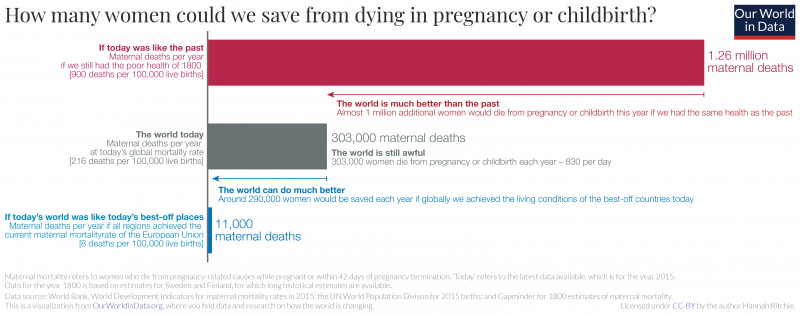830 women die from pregnancy-related causes every day.1 In 2015, 302,700 women in the world died as a result of pregnancy or childbirth.
For many aspects in global development it is true that the world made a lot of progress in the past and we know that we can make a lot of progress still. We’ve shown this before for child mortality and it is true for maternal health too: maternal health is much better than the past; it’s still awful today; and we can do much better.
In the visualization here we compare three scenarios:
- How many mothers would die today if we still had the very poor health of the past? Even the countries with the best maternal health today had very high maternal mortality rates in the past. In Sweden and Finland in 1800, for example, around 900 mothers died for every 100,000 live births [nearly 1-in-100].2 In today’s world where 140 million women give birth each year this would mean that 1.26 million would die.
- The world today: the actual number of women that died from pregnancy-related causes in 2015 was 302,700.
- If all regions had the health of today’s best-off countries: Today the world region with the lowest maternal mortality is the European Union, where 8 women die per 100,000 live births. In today’s world where 140 million women give birth each year, if all countries had this level of maternal mortality, 11,000 would die.3
We can see how much global maternal health is improved: if we still had the living standards of 1800, around 1.26 million women would die from pregnancy every year. Almost one million more women would die each year.
But we also see how far we could go. If all regions achieved the healthcare and living standards of the EU very few women would die. Almost 300,000 fewer deaths ; a reduction of over 95%. If we think of it in this way, almost all of the world’s maternal deaths are preventable with adequate maternal care, safe deliveries, good nutrition and hygiene and sanitation.4 This is also the message of the World Health Organization: “Every day, approximately 830 women die from preventable causes related to pregnancy and childbirth.
That most of the world’s maternal deaths could be prevented also becomes clear when we consider that 95% occur in low and lower-middle income countries. Maternal mortality is much more common in poorer countries.
It’s unacceptable that a woman in Sierra Leone is 300 to 400 times more likely to die during pregnancy or childbirth than a woman in Sweden or Finland and we know it is possible to prevent these deaths.
If we can make maternal deaths as rare as they are in the healthiest countries in the world we can save almost 300,000 mothers each year.
